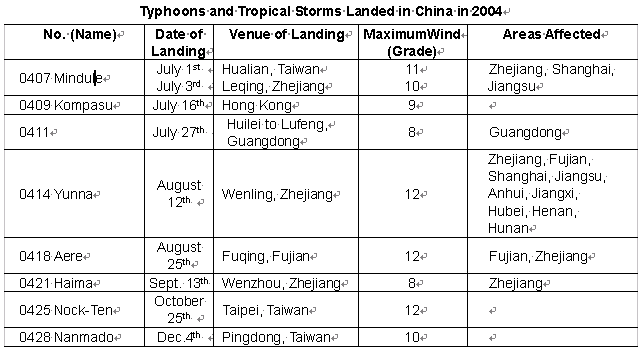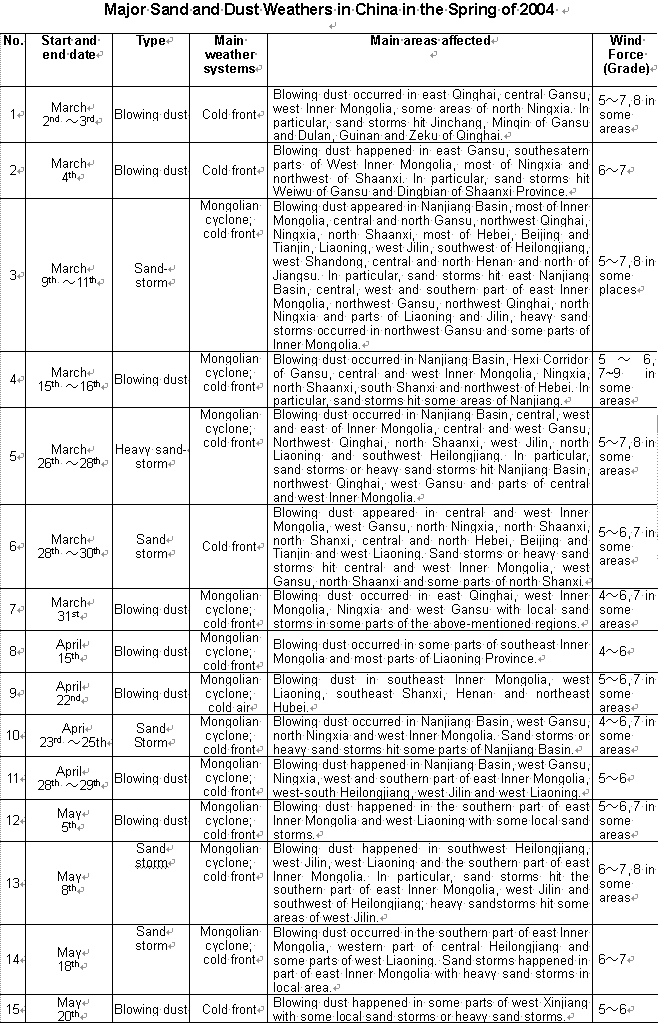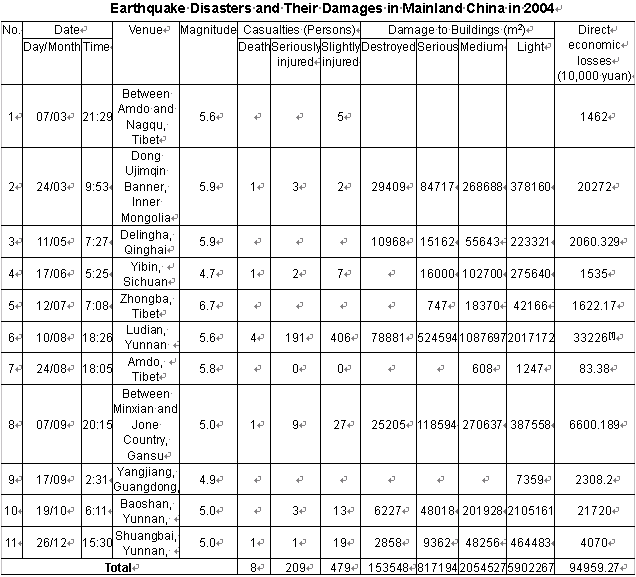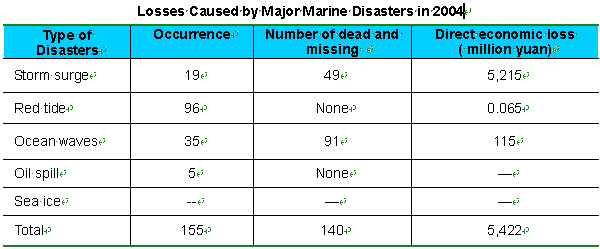
Report On the State
of the Environment In China
2 0 0 4
Climate and Natural Disasters
General Situation
General Climate Situation in China
In 2004 (from January to December), the average annual precipitation of the country was a little less than historical average. The annual average temperature was higher than the historical average for the eighth consecutive year. In 2004, most parts of mainland China received abundant sunshine with evenly distributed precipitation. Climactic disasters were less serious than the previous several years, and the climate was normal on the whole. The climatic situation in 2004 was in general
"better than normal level".
Precipitation Distribution The average annual precipitation of China in 2004 was 590.6 mm, 22.1 mm less than the historical average. In regions such as the eastern and southern parts of northeast China, southeast part of north China, lower reaches of the Yellow River, most parts to the south of the Weihe River, the annual precipitation was over 500 mm. Among them, the middle and lower reaches of the Yangtze River, most parts of the region to its south bank and some areas of the eastern part of southwest China received 1000 mm ~ 2000 mm of precipitation. Guangxi, Yunnan and part of Jiangxi Provinces had annual precipitation over 2000 mm. As for the rest parts of China, the precipitation was less than 500 mm. When it compared with normal years, most parts of Northeast and Northwest China, the southern regions to the Yellow River and Huaihe River, most parts of the Yangtze River and Huaihe River as well as that of the southern region to the Yangtze River and certain areas of South China and Southwest China saw less annual precipitation than the historical average to various degrees. Among them, the adjacent areas of the 3 provinces (autonomous region) of Heilongjiang, Jilin and Inner Mongolia, eastern part of southern Xingjiang, western parts of Gansu Province and Tibet, eastern part of Guangdong and the coastal areas, eastern part of Hainan, southwest of Fujiang and central part of Jiangsu had a reduction by 30% to 80% compared with the historical average. However, the precipitation of most parts of North China, northern parts of the Yellow River and Huaihe River, most parts of Southwest China and part of Northwest China enjoyed more precipitation compared with the historical average at various degrees. Among them, the central part of Shandong, central part of Qinghai and northwestern part of Xinjiang had an increase of 30% to 100% in precipitation.

Changes in Average Annual Precipitation of China (in millimeter)

Distribution of Precipitation in China in 2004 (in millimeter)

Percentage Gap Distribution of Precipitation to the National Average in 2004 (%)
Temperature Distribution The national annual average temperature in 2004 (from January to December) was 9.6℃, 0.8℃ higher than the historical average. It was also the forth warmest year after 1998, 1999 and 2002 in over 4 decades since 1961. Besides, the annual temperature was higher than the historical average for the 8th consecutive year but with evident stage fluctuations. Some areas were subject to low temperature, freeze damage or snow disasters while South China witnessed continuous high temperature period in midsummer.

Changes of Annual Average Temperature of China (℃)

Percentage Gap Distribution of Annual Average Temperature to the National Average in 2004(%)
Climate Disasters In 2004, China experienced various kinds of climatic disasters such as drought, rainstorm and flood, typhoon, hail, high temperature, snow disaster, low temperature and freeze damage, etc. The climatic disasters were characterized by "various kinds, high frequency, starting early and ending late, widespread and with great influence". Judging from the area of disaster-afflicted farmland, we could see that the main climatic disasters were drought, rainstorm and flood, accounting for 70% of the total affected areas.
【Drought】Eastern part of Inner Mongolia and western part of Northeast China had very little precipitation (snow) from January to the early June in 2004 with total precipitation less than 100 mm, 50% to 80% less than the historical average at the same period. The average regional precipitation was the least since 1951, causing the most severe drought in the region at the same period of the year for the past 50 years. Most parts of South China had seen continuous less precipitation since autumn. The average regional precipitation of some provinces in South China and the regions along the middle and lower reaches of the Yangtze River in September and October was as low as 98 mm., the least amount since 1951. At the beginning of November, the drought-afflicted area expanded to almost the entire region of South China and the middle and lower reaches of the Yangtze River. Among them, some regions such as Guangxi, most of Guangdong, Hainan, southwestern Fujian, southern part of Hunan, eastern part of Hubei, most of Jiangxi, central and southern parts of Jiangsu and Anhui and northern part of Zhejiang were suffering from heavy drought with some areas experiencing very heavy drought.
【Typhoon and Tropical Storm】 There were 8 typhoons or tropical storms landed in China in 2004. The economic loss caused by these typhoons was less than the average level since 1990. However, No. 0414 typhoon of "Yunna" was very strong and hit Zhejiang province destructively. It was the strongest among all those landed in China during the past 8 years since the No. 15 typhoon in 1996.
【Storm and Flood】The city of Beijing was hit by a big storm on July 10th of 2004. The maximum hourly precipitation of Fengtai District was 52 mm, and the 10 min. maximum precipitation reached 23 mm. As a result, water pooled heavily in some road sections, severely paralyzing the city traffic. In the evening of July 12th, a furious storm suddenly hit Shanghai. Although it lasted for less than an hour, the precipitation was 30 mm, and the maximum wind scale reached about 9 to 11. From September 3rd to 6th, storm and heavy storm hit the eastern part of Sichuan, Chongqing and other places. It was the heaviest in the northeastern part of Sichuan in history and also the heaviest regional precipitation for Chongqing Municipality since 1982. From September 7th to 10th, a strong storm swept the coastal areas of central and southern parts of Fujian. Among those affected areas, the total precipitation in Pingtan of Fujian Province during the storm was 420.1 mm, and the 24-hour precipitation reached 250.8 mm, breaking the historical record of heaviest daily precipitation in September since 1951. This strong rainstorm caused such disasters as regional floods and local landslides. On November 9th, a storm seldom seen in late autumn hit Taizhou and Wenzhou cities of Zhejiang Province. The 24-hour precipitation in Wenling amounted to 253.1 mm, setting a new record of maximum daily precipitation in November in Zhejiang.
【Sand Storm】 During the spring of 2004, 15 sand and dust storms occurred in across China, an apparent increase than the same period of the previous year. However, the number of days with sand and dust storms declined compared with the same period in past years.
【Thunderstorm】Regional thunder strikes appeared in China frequently in 2004. According to statistics from July to December of 2004, some provinces such as Zhejiang, Guangdong, Yunnan, Hebei, Anhui, Jiangsu, Hubei, Sichuan, Shanxi and Xinjiang reported cases of thunder strikes, causing at least 234 deaths. Among them, 17 were hit by thunder and lightning in Linhai of Zhejiang on June 26th. In another case, when some local residents took shelters from the rain at the Fengfeng coal mines in Handan City of Hebei Province, they were hit by thunder and lighting, causing 5 death and 13 injured.


Earthquake Disasters In 2004, China had experienced 34 earthquakes at or over the scale of Richter 5, five of which were of Richter scale 6 ~ 7 and the remaining 29 were of Richter 5 ~ 6. Mainland China was hit by 22 earthquakes and Taiwan by12 quakes.
11 of the earthquakes that occurred in the mainland in 2004 caused disasters. The total area affected by the disasters was approximately 20,815
km2. The population affected by the disasters was 950 thousand. 8 people died, 209 heavily injured, and 479 lightly injured. The disasters altogether caused damages to houses of 153,548
m2, among which 817,194 m2 were of severe damage, 2,054,527
m2 were of medium damage and 5,902,267 m2 of slight damage. The direct economic loss caused by earthquake disasters was RMB 950 million.

Note: item [1] included the economic losses caused to Guizhou Province of RMB 12.36 million yuan.
Geological Disasters In 2004, a total of 13,555 geological disasters happened in China, 976 of which had caused casualty or economic loss over 500,000 yuan. Those disasters led to overall casualty of 1,407 with 734 dead, 124 missing, 549 injured and the direct economic loss of 4.09 billion yuan RMB. Since disaster prevention and control work during the rain season of 2004 attained evident effects, 723 geological disasters were successfully forecasted across China, avoiding the potential casualty of 47,614 people.
Marine Disasters 2004 was a normal year in terms of marine disasters. There were 155 disasters of storm surges, red tides and oil spill during the whole year, causing direct economic losses of about RMB 5.4 billion yuan with 140 people dead or missing. The direct economic losses resulting from storm surges, red tides and ocean waves cut down by 33% compared with that of the previous year. Among them, storm surges were the major marine disasters in 2004 and caused 5.215 billion yuan of direct economic losses with 49 people dead or missing. Ocean waves brought a direct economic loss of about 207 million yuan. Red tides and oil spill also led to some economic losses. However, sea ice
didn't cause any apparent economic loss.

Note: The damage of coastal wave disasters was included in that of the storm surge.
Countermeasures and Actions
【Prevention of Geological Disasters】 The Central Government promulgated the
Regulations on the Prevention and control of Geological Disasters and formulated the
National Plan for Geological Disaster Prevention and Control and the
National Emergency Plan for Unexpected Geological Disaster. It has further improved the meteorological pre-warning work on geological disasters.
【Forecast and Warning of Weather Causing Geological Disasters】 The State Meteorological Administration and the Ministry of Land and Resources jointly released 88 pre-warning and forecast on geological disaster weather on weather forecast program of CCTV from May 1st to September 30th of 2004. Among them, 8 were warnings. A total of 722 geological disasters were successful forecasted in the whole year. The forecast and early warning secured the life of 47,000 people and properties worth of RMB 450 million yuan. On August 25th, they released the warning of a 5-degree geological disaster to the regions of Fujian and Zhejiang. The local government then removed over 30,000 people and major assets to safe places, avoiding casualty and potential severe economic losses.
【Precise Forecast of Typhoon "Aere"】 The Central Meteorological Observatory, Fujian Meteorological Observatory and Xiamen Meteorological Observatory
m ade a quite precise forecast on the landing venue and time of Typhoon
"Aere". Accordingly, 516,000 people were evacuated in advance, and 10,676 ships were requested to go back to the harbor. As a result, not a single person was injured or died under the typhoon.
【Artificial Rainfall Enhancement and Hail Prevention】 In 2004, the overall target area for artificial rainfall enhancement projects was over 3 million
km2 nationwide. 34 planes were leased with accumulated 613 sorties of flying tasks totaling 1605 hours. Artificial rainfall increase by high-angle gun and rockets totaled over 15,100 times. Over 41,200
times' artificial hail prevention tasks were carried out in 24 provinces (autonomous regions, municipalities), Dalian, Qingdao and Xinjiang Production and Construction Corps, covering an area of over 430,000
km2. This work had effectively prevented and reduced hail damage to agriculture.
【National Earthquake Prevention and Disaster Relief Meeting】 The State Council held a National Earthquake Prevention and Disaster Relief Meeting in July of 2004. The meeting made an overall review of the achievements and experience in the fields of earthquake prevention and disaster relief in recent years; analyzed the earthquake situation and tasks China was facing with; and further identified the guideline of
"paying equal attention to earthquake prevention and disaster relief and economic development, putting more emphasis on prevention with the integration of prevention and
relief". The meeting also set down the goal that "China shall be obtain the capacity in withstanding Richter 6 earthquake equivalent to the basic earthquake degree of different regions, the earthquake prevention and disaster relief capacity of large and medium-sized cities and economically-developed regions shall reach the level of intermediate developed
countries".
【Prevention of Earthquake Disasters】 Premier Wen Jiabao signed the No. 409 Order of the State Council for the issuing of
Rules and Regulations on the Management of Earthquake Monitoring, which went into effect since September 1st of 2004. This Regulation spelled out the major principles on the management of earthquake monitoring stations or network, the terms of reference of earthquake monitoring work, policies of the Central Government on earthquake monitoring work as well as the business operation licensing for foreign organizations and individuals in this field.
【International Emergency Aids on Tsunami Disasters】 On December 26th, 2004, a strong earthquake measuring Richter scale 8.7 occurred in the offshore area of Sumatera in Indonesia triggered a huge tsunami in the area, causing great casualty and economic losses. In reaction to the request of Indonesian Government, the Chinese International Rescuing Team sent 70 peoples in two batches for disaster relief work in Banda Aceh of Indonesia after getting the approval of the State Council and the Military Committee of the Central Government. Under the arrangement of the Office for the Coordination of Humanity Affairs (OCHA) of the United Nation, the rescue team treated and rescued over 10,000 person-times, searched and removed 69 bodies. The team also carried out a series of works including sanitation and epidemic prevention, helping the seriously damaged Central Hospital of Banda Aceh to restore its capacity, conducting disaster result investigation and earthquake trend analysis. The Rescuing Team stayed in the area for 28 days.
Climate and Natural Disasters